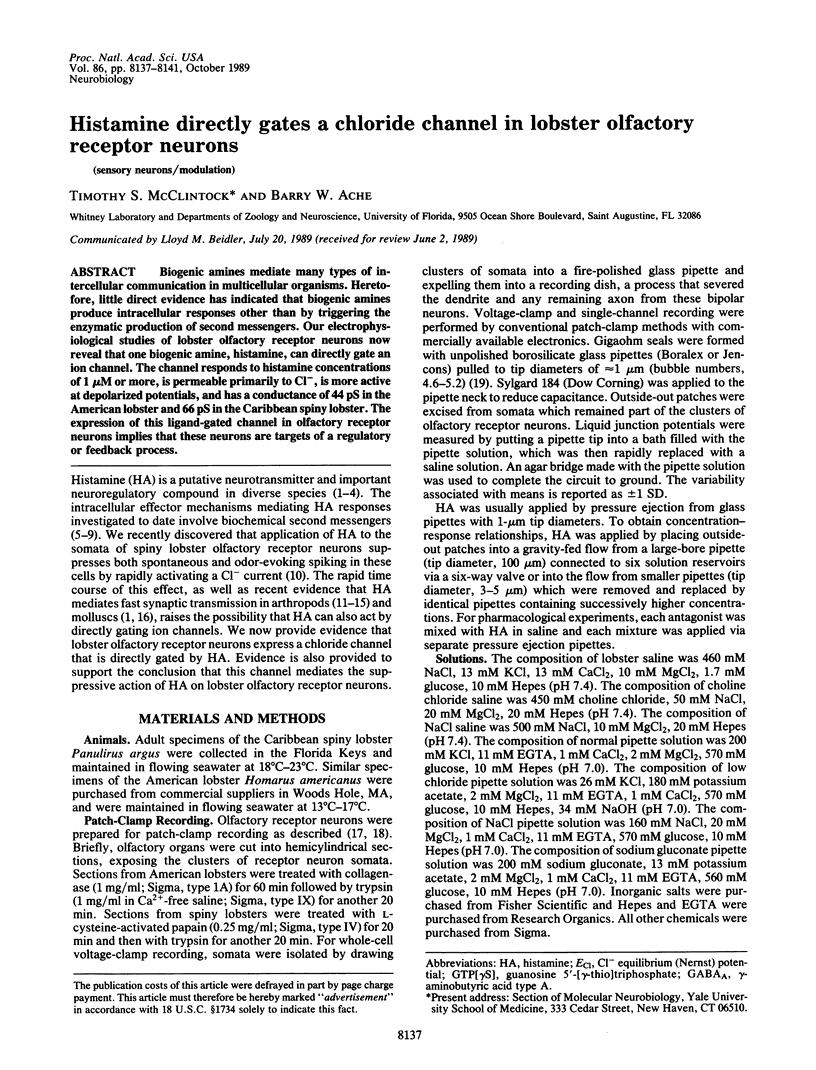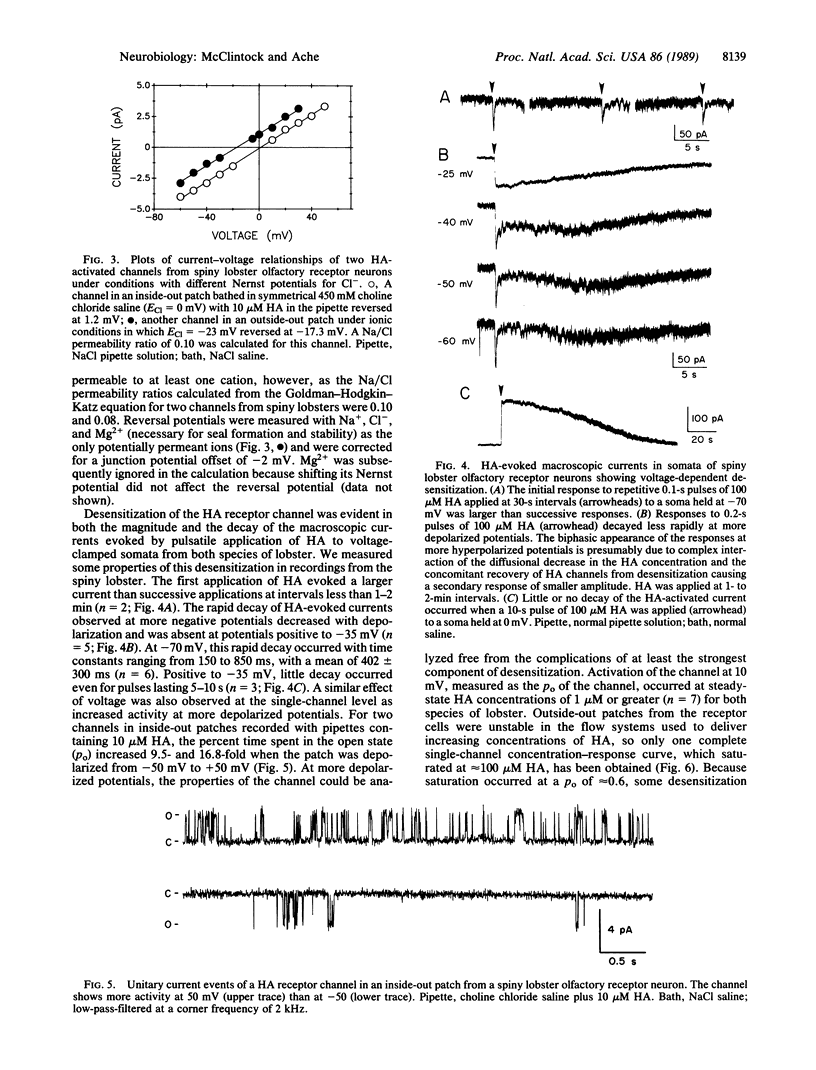Abstract
Biogenic amines mediate many types of intercellular communication in multicellular organisms. Heretofore, little direct evidence has indicated that biogenic amines produce intracellular responses other than by triggering the enzymatic production of second messengers. Our electrophysiological studies of lobster olfactory receptor neurons now reveal that one biogenic amine, histamine, can directly gate an ion channel. The channel responds to histamine concentrations of 1 microM or more, is permeable primarily to Cl-, is more active at depolarized potentials, and has a conductance of 44 pS in the American lobster and 66 pS in the Caribbean spiny lobster. The expression of this ligand-gated channel in olfactory receptor neurons implies that these neurons are targets of a regulatory or feedback process.
Full text
PDF




Selected References
These references are in PubMed. This may not be the complete list of references from this article.
- Anderson P. A., Ache B. W. Voltage- and current-clamp recordings of the receptor potential in olfactory receptor cells in situ. Brain Res. 1985 Jul 15;338(2):273–280. doi: 10.1016/0006-8993(85)90157-x. [DOI] [PubMed] [Google Scholar]
- Blair L. A., Levitan E. S., Marshall J., Dionne V. E., Barnard E. A. Single subunits of the GABAA receptor form ion channels with properties of the native receptor. Science. 1988 Oct 28;242(4878):577–579. doi: 10.1126/science.2845583. [DOI] [PubMed] [Google Scholar]
- Bormann J., Clapham D. E. gamma-Aminobutyric acid receptor channels in adrenal chromaffin cells: a patch-clamp study. Proc Natl Acad Sci U S A. 1985 Apr;82(7):2168–2172. doi: 10.1073/pnas.82.7.2168. [DOI] [PMC free article] [PubMed] [Google Scholar]
- Bormann J. Electrophysiology of single GABA receptor chloride channels. Clin Neuropharmacol. 1986;9 (Suppl 4):386–388. [PubMed] [Google Scholar]
- Brown E., Kendall D. A., Nahorski S. R. Inositol phospholipid hydrolysis in rat cerebral cortical slices: I. Receptor characterisation. J Neurochem. 1984 May;42(5):1379–1387. doi: 10.1111/j.1471-4159.1984.tb02798.x. [DOI] [PubMed] [Google Scholar]
- Claiborne B. J., Selverston A. I. Histamine as a neurotransmitter in the stomatogastric nervous system of the spiny lobster. J Neurosci. 1984 Mar;4(3):708–721. doi: 10.1523/JNEUROSCI.04-03-00708.1984. [DOI] [PMC free article] [PubMed] [Google Scholar]
- Codina J., Yatani A., Grenet D., Brown A. M., Birnbaumer L. The alpha subunit of the GTP binding protein Gk opens atrial potassium channels. Science. 1987 Apr 24;236(4800):442–445. doi: 10.1126/science.2436299. [DOI] [PubMed] [Google Scholar]
- Coulombe A., Duclohier H., Coraboeuf E., Touzet N. Single chloride-permeable channels of large conductance in cultured cardiac cells of new-born rats. Eur Biophys J. 1987;14(3):155–162. doi: 10.1007/BF00253840. [DOI] [PubMed] [Google Scholar]
- Daum P. R., Downes C. P., Young J. M. Histamine stimulation of inositol 1-phosphate accumulation in lithium-treated slices from regions of guinea pig brain. J Neurochem. 1984 Jul;43(1):25–32. doi: 10.1111/j.1471-4159.1984.tb06674.x. [DOI] [PubMed] [Google Scholar]
- Derkach V., Surprenant A., North R. A. 5-HT3 receptors are membrane ion channels. Nature. 1989 Jun 29;339(6227):706–709. doi: 10.1038/339706a0. [DOI] [PubMed] [Google Scholar]
- Franciolini F., Nonner W. Anion and cation permeability of a chloride channel in rat hippocampal neurons. J Gen Physiol. 1987 Oct;90(4):453–478. doi: 10.1085/jgp.90.4.453. [DOI] [PMC free article] [PubMed] [Google Scholar]
- Gruol D. L., Weinreich D. Two pharmacologically distinct histamine receptors mediating membrane hyperpolarization on identified neurons of Aplysia californica. Brain Res. 1979 Feb 23;162(2):281–301. doi: 10.1016/0006-8993(79)90290-7. [DOI] [PubMed] [Google Scholar]
- Hardie R. C. A histamine-activated chloride channel involved in neurotransmission at a photoreceptor synapse. Nature. 1989 Jun 29;339(6227):704–706. doi: 10.1038/339704a0. [DOI] [PubMed] [Google Scholar]
- Hardie R. C. Is histamine a neurotransmitter in insect photoreceptors? J Comp Physiol A. 1987 Aug;161(2):201–213. doi: 10.1007/BF00615241. [DOI] [PubMed] [Google Scholar]
- Hegstrand L. R., Kanof P. D., Greengard P. Histamine-sensitive adenylate cyclase in mammalian brain. Nature. 1976 Mar 11;260(5547):163–165. doi: 10.1038/260163a0. [DOI] [PubMed] [Google Scholar]
- Kretz R., Shapiro E., Bailey C. H., Chen M., Kandel E. R. Presynaptic inhibition produced by an identified presynaptic inhibitory neuron. II. Presynaptic conductance changes caused by histamine. J Neurophysiol. 1986 Jan;55(1):131–146. doi: 10.1152/jn.1986.55.1.131. [DOI] [PubMed] [Google Scholar]
- Laughlin S. B., Howard J., Blakeslee B. Synaptic limitations to contrast coding in the retina of the blowfly Calliphora. Proc R Soc Lond B Biol Sci. 1987 Sep 22;231(1265):437–467. doi: 10.1098/rspb.1987.0054. [DOI] [PubMed] [Google Scholar]
- McCaman R. E., Weinreich D. Histaminergic synaptic transmission in the cerebral ganglion of Aplysia. J Neurophysiol. 1985 Apr;53(4):1016–1037. doi: 10.1152/jn.1985.53.4.1016. [DOI] [PubMed] [Google Scholar]
- Mittman S., Flaming D. G., Copenhagen D. R., Belgum J. H. Bubble pressure measurement of micropipet tip outer diameter. J Neurosci Methods. 1987 Dec;22(2):161–166. doi: 10.1016/0165-0270(87)90010-0. [DOI] [PubMed] [Google Scholar]
- Prell G. D., Green J. P. Histamine as a neuroregulator. Annu Rev Neurosci. 1986;9:209–254. doi: 10.1146/annurev.ne.09.030186.001233. [DOI] [PubMed] [Google Scholar]
- Sasaki K., Sato M. A single GTP-binding protein regulates K+-channels coupled with dopamine, histamine and acetylcholine receptors. Nature. 1987 Jan 15;325(6101):259–262. doi: 10.1038/325259a0. [DOI] [PubMed] [Google Scholar]
- Schwartz J. C., Arrang J. M., Garbarg M., Korner M. Properties and roles of the three subclasses of histamine receptors in brain. J Exp Biol. 1986 Sep;124:203–224. doi: 10.1242/jeb.124.1.203. [DOI] [PubMed] [Google Scholar]
- Siegelbaum S. A., Belardetti F., Camardo J. S., Shuster M. J. Modulation of the serotonin-sensitive potassium channel in Aplysia sensory neurone cell body and growth cone. J Exp Biol. 1986 Sep;124:287–306. doi: 10.1242/jeb.124.1.287. [DOI] [PubMed] [Google Scholar]
- Spencer M., Linberg K. A. Ultrastructure of aesthetasc innervation and external morphology of the lateral antennule setae of the spiny lobster Panulirus interruptus (Randall). Cell Tissue Res. 1986;245(1):69–80. doi: 10.1007/BF00218088. [DOI] [PubMed] [Google Scholar]
- Stanley E. F., Ehrenstein G., Russell J. T. Evidence for anion channels in secretory vesicles. Neuroscience. 1988 Jun;25(3):1035–1039. doi: 10.1016/0306-4522(88)90056-5. [DOI] [PubMed] [Google Scholar]
- Tamura K., Palmer J. M., Wood J. D. Presynaptic inhibition produced by histamine at nicotinic synapses in enteric ganglia. Neuroscience. 1988 Apr;25(1):171–179. doi: 10.1016/0306-4522(88)90016-4. [DOI] [PubMed] [Google Scholar]
- Weiss D. S. Membrane potential modulates the activation of GABA-gated channels. J Neurophysiol. 1988 Feb;59(2):514–527. doi: 10.1152/jn.1988.59.2.514. [DOI] [PubMed] [Google Scholar]
- Yakel J. L., Jackson M. B. 5-HT3 receptors mediate rapid responses in cultured hippocampus and a clonal cell line. Neuron. 1988 Sep;1(7):615–621. doi: 10.1016/0896-6273(88)90111-0. [DOI] [PubMed] [Google Scholar]
- Yatani A., Codina J., Imoto Y., Reeves J. P., Birnbaumer L., Brown A. M. A G protein directly regulates mammalian cardiac calcium channels. Science. 1987 Nov 27;238(4831):1288–1292. doi: 10.1126/science.2446390. [DOI] [PubMed] [Google Scholar]


